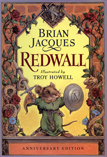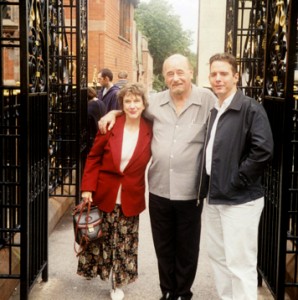Novels edited by Patricia Lee Gauch
Stories Behind Stories


Patti, Brian Jacques, artist Christopher Denise
In the end, I decided that Brian’s characters and indeed the plots themselves always strove for peace, and he celebrated the animals’ efforts vibrantly. Writing in longhand in his writing shed in Liverpool, England, he would then gather his 400-plus pages and bring them to me, reading to me the first pages of his finally typed manuscript. What a extraordinary experience for me! I have always thought Brian a genius, through all sixteen Redwall books I edited. And still do. In many ways, publishing to the numbers that he did, he not only etched out a permanent place for himself in the young reader’s genre, he prepared the way for Harry Potter.

Patti and T.A. Barron, about 1990
Other Novels, with commentary
As with picture books, novels are selected carefully because the process to make a novel is a lengthy one, and the young adult audience is particular! This list, then, is just a sampling.

I Am Regina by Sally Keehn, an Indian captive story which became a staple in classrooms across the country.
Miracle at Clement’s Pond by Patricia Pendergraft, a country tale about a child who is left on the doorstep of a villager’s house. A movie, as well as popular novel.
Things Not Seen by Andrew Clements, a modern classic about a boy who wakes up and is truly invisible. First in cycle of three books about Robert who, in becoming invisible, begins to truly see.

Our Secret: Siri Aang, by Cristina Kessler, an African story, authentic and touching, about a girl who bravely befriends a rhinoceros and is confronted by hunters. Winner of the ASCPA Henry Bergh Children’s Book Award.

Highway Cats by Janet Lisle, a sassy, witty and important story about a group of scruffy cats occupying an old cemetery who in adopting three castaway kittens, discover their own courage and stand up to city bulldozers trying to steal their land.
When the Whistle Blows by Fran Slayton. A story about a railroad town that is threatened when the diesel takes over, and about a young boy who adventures in these last days. The second from the last chapter when the father saves his son is one of the best I have read in all my years as reader.

Mockingbird by Kathryn Erskine. National Book Award for Excellence in Children’s Literature, 2010. A powerfully warm and poignant story told by Scout, an Asperger’s Syndrome child who, on the death of her beloved brother, is in search of “closure.”

The Queen’s Own Fool by Jane Yolen and Robert Harris. The fool of Mary Queen of Scots gives readers an inside glimpse of the loves and adventures and eventual escape of the Scottish queen. First of a Scottish quartet of adventure-loving historical fiction by the duo.
Blue Stem by Frances Arrington: Set in a prairie world of the 1870s, two young sisters, suddenly alone on the prairie but armed with their love for each other, dare to face a challenging new world. Arrington captures the beauty of the prairie itself in poetic prose, as well as the pioneer spirit of the heroic girls.
The War of Jenkins’ Ear by Michael Morpurgo. Morpurgo turns a private country school inside out, bringing to life one of my favorite characters, Christopher, a new boy with a secret and no fear of anyone. Or anything.
Cousins by Virginia Hamilton. Using her remarkable voice, Newbery award winner Hamilton introduces five unforgettable cousins.